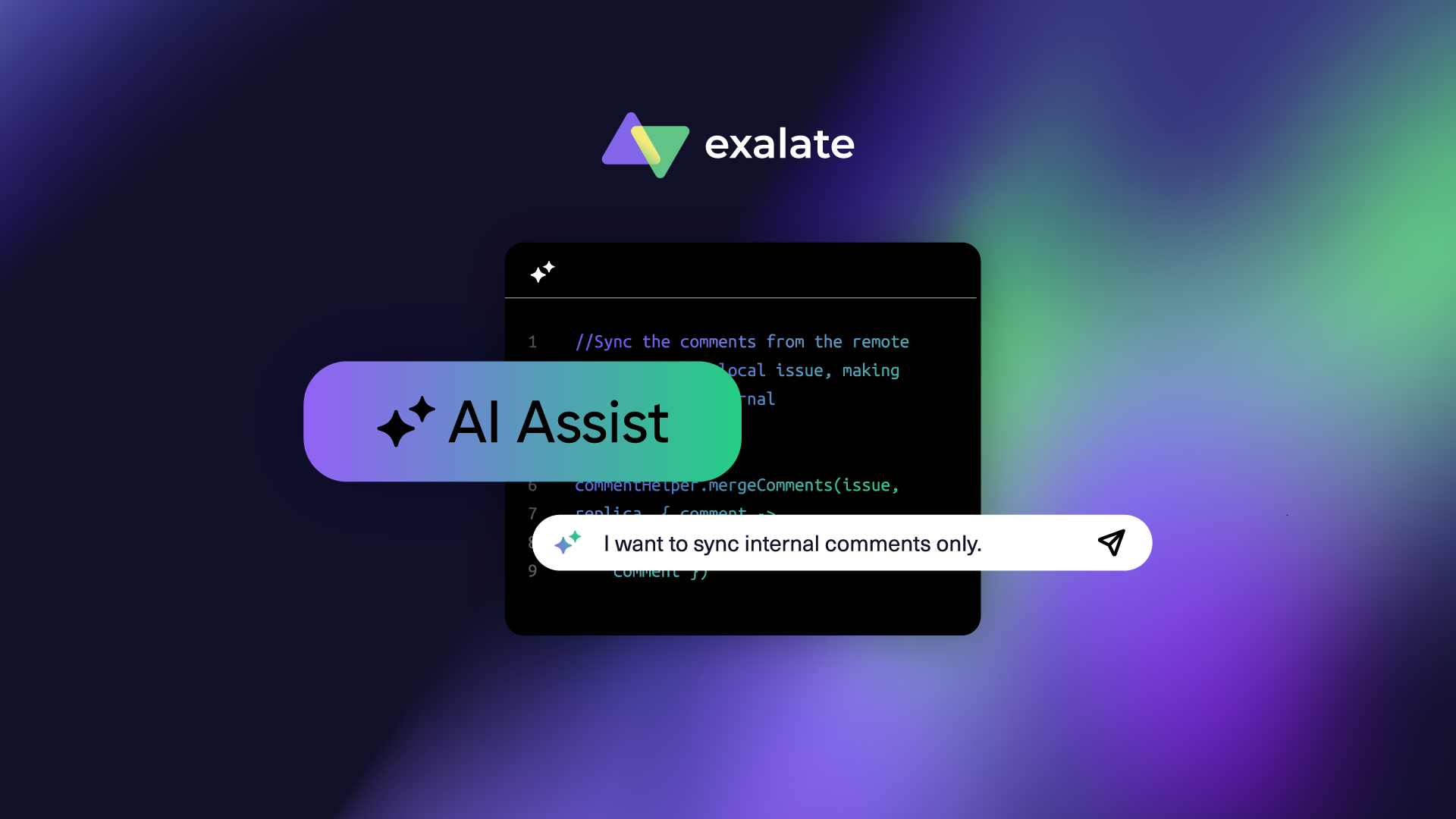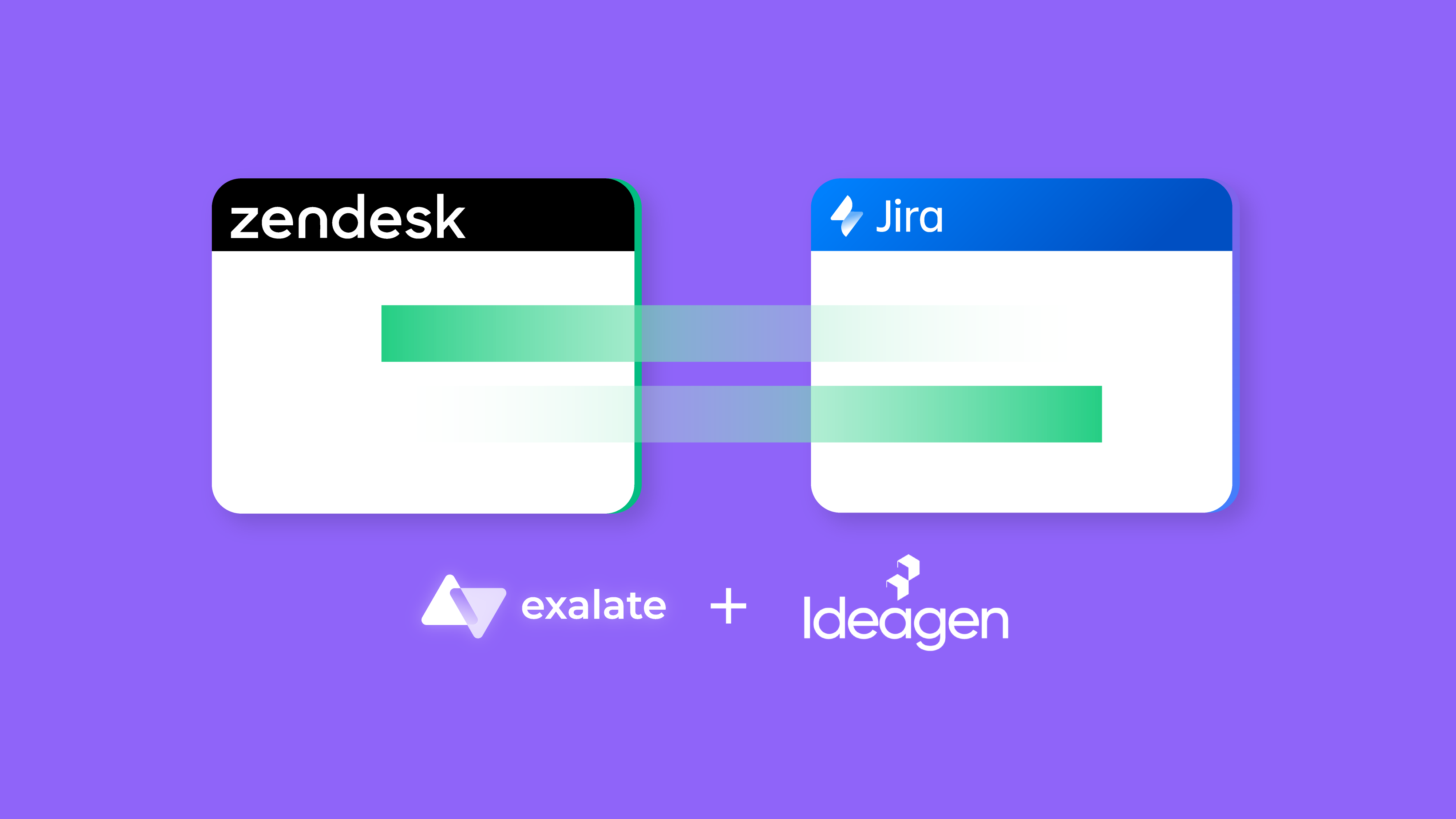Tracking and managing projects using commercial software solutions like Jira, Azure DevOps, or ServiceNow is not new. Such tools make the life of project managers easier and hassle-free.
An organization might have suppliers, customers, and partners that probably work on their systems. In order to collaborate with them in a seamless way, you need these different systems to communicate with each other without any mistakes.

Thankfully, software integration tools like TFS4JIRA and Exalate can save time, money, and above all sanity. They integrate different systems by synchronizing data between them. This is especially useful when you want to share data outside your organization.
Here is your complete comparison between TFS4JIRA and Exalate, where we compare features, functionality, and pricing in detail. You can then determine the solution best suited for your business scenario.

What is TFS4Jira?
TFS4JIRA is an integration and migration plugin to connect two solutions: Jira (Cloud and on-premise) and Azure DevOps/TFS. It helps to integrate and synchronize changes made to the issues and work items between Jira and TFS/Azure DevOps platforms.

What is Exalate?
Exalate is an integration solution that synchronizes various entities bi-directionally between multiple applications like Jira (Cloud and on-premise), Azure DevOps, ServiceNow, Salesforce, Zendesk, GitHub, etc.
TFS4JIRA vs Exalate: The Complete Comparison
TFS4JIRA Vs. Exalate: User Friendliness
Exalate supports a drag-and-drop interface (Basic mode and Visual mode) that provides pre-defined mappings between fields like status, issue types, description, etc. It also has a scripting interface (Script mode) that helps customize the sync according to specific business use cases.

These modes make Exalate easy to use for both technical and business users.
TFS4Jira has a no-code interface called synchronization profiles. Once you create a synchronization profile between Jira and Azure DevOps/ TFS, information can flow automatically between both platforms.

➜ User Friendliness winner: Exalate
TFS4JIRA Vs. Exalate: Supported Platforms
TFS4JIRA supports the following:
- Jira (Cloud and on-premise)
- Azure DevOps Cloud
- TFS (Team Foundation Server)
Exalate supports the following:
- Jira (Cloud and on-premise)
- Azure DevOps
- ServiceNow
- Zendesk
- GitHub
- Salesforce
- Docker installations for all the platforms.
You can also set up the same platform integrations with Exalate, for instance, Jira to Jira integration, ServiceNow to ServiceNow integration, Salesforce to Salesforce integration, etc.

➜ Supported Platforms winner: Exalate
TFS4JIRA Vs. Exalate: Data Sync Coverage (Product Scope)
TFS4Jira and Exalate are both one-way or two-way synchronization apps with similar capabilities. In Jira, you can sync issue fields like summary, description, attachments, status, priority, assignee, etc.
You can also sync and maintain issue links and hierarchies, sub-tasks, etc.
On the Azure DevOps side, you can sync work items, descriptions, priorities, states, comments, etc.
Both support connecting multiple Azure DevOps instances, but Exalate also supports connecting multiple Jira instances.
Exalate’s powerful Groovy-based scripting engine gives unlimited flexibility in defining mapping and sync rules logic. So you can perform deep integrations between different platforms. For instance, you can map the data coming from a single Jira issue under two different Azure DevOps projects.
You can sync almost any information with the help of Exalate scripts and Script Helpers.

Also, Exalate:
- expands your Jira Azure DevOps sync to additional connectors like Salesforce, ServiceNow, etc.
- offers advanced sync triggers in the platform-native query language to provide granular control over information exchange.
- can perform bulk operations on multiple entities using the Bulk Connect and Bulk Exalate features.
- unlink and reconnect entities whenever you want.
- sync a variety of custom fields created by add-ons such as syncing Insights fields and tempo work logs.

➜ Data Sync Coverage Winner: Exalate
TFS4JIRA Vs. Exalate: Centralized or Decentralized Integration
Exalate supports decentralized integration that allows you to retain full control of your environment by specifying what information needs to remain with you and what needs to be passed between systems. It allows the systems to be loosely coupled and independent of each other, increasing scalability, maintainability, and security.
Using Exalate, you can configure the incoming and outgoing syncs using sync rules on either side without the other party knowing about it. This allows you to have more control over the data being synchronized. This is possible only with a distributed architecture.

TFS4JIRA has a centralized architecture where the TFS4JIRA Synchronizer works as a centralized entity through which all synchronization requests have to pass through. So either of the collaborating parties can make changes to the synchronization profiles, but those changes need to be updated on the synchronizer as well. You also need admin access to both systems in order to set up a sync.
➜ Decentralized Integration Winner: Exalate
TFS4JIRA Vs. Exalate: Use Cases
Both TFS4Jira and Exalate support a wide variety of use cases that are similar in nature.
- Bi-directional Issue sync: Often, teams need to raise a bug, blocker, issue, or request with another responsible team without the need for manual follow-ups. Such teams can be within the same company or belong to different companies. For example, a support team using Jira may need to escalate tickets to the development team using Azure DevOps without the need for additional communication channels like Slack or emails. Similarly, customer success executives can raise customer issues to be addressed by the product team and prioritized on the product roadmap.
- Unified reporting and metrics: Top management needs information gathered and centralized from multiple sources to facilitate efficient decision-making. For example, developers commonly use Azure DevOps. Providing clear visibility of issue statuses and blockers to the project managers using Jira, enabling them to prioritize the backlog, align issues for releases or sprints, and make informed decisions.
- Custom-field mapping and sync: You can map custom fields and synchronize workflows of Azure DevOps and Jira such that the unique requirements and processes of each platform are respected and maintained during the sync process. For instance, development (or engineering) teams using Azure DevOps have their own workflow with custom fields suitable to their project. Similarly, the QA team working in Jira has its own set of workflows and custom fields. These workflows and custom fields must be mapped correctly and the required information be synced automatically to ensure every team has visibility and status updates.
The real difference between the tools becomes evident if the use case gets customized and complex. With Exalate’s intuitive scripting engine, you have a lot of power to control every aspect of your integration at a very granular level. On the other hand, TFS4Jira’s central, no-code configuration confines the use cases to the mapping provided by its UI.
Let’s look at a few examples of how Exalate can be used for advanced use cases:
- It can help you sync almost any information that can be accessed via open APIs with simple, easy-to-follow code.
- It can implement complex mappings and inter-dependencies between entities using Groovy-based scripts.
- It is an excellent choice for cross-company integrations due to its distributed architecture. It provides a flexible integration platform to connect and synchronize data between multiple ITSM tools like Jira, Salesforce, ServiceNow, and Zendesk. It also offers a special plan, Exalate for Service Providers, which assists in setting up and deploying the Exalate network. This plan simplifies the consolidation of service providers and customers, relieving you of integration complexities and maintenance. The integration experts at Exalate will handle the custom connectors required for any system used by your partners, suppliers, or customers.

➜ Use Cases winner: Exalate
TFS4JIRA Vs. Exalate: Security and Compliances
Exalate has the usual security measures in place like JWT-based tokens, data encryption at rest and in transit, use of HTTPS traffic between the Exalate node and the instance, OAuth, or token-based authentication mechanisms wherever applicable.
It also has a few other distinct security measures:
- It has a single-tenant architecture so that each Exalate node and its corresponding instance share a unique file, network, and process space. This protects your company data from unauthorized access.
- It provides decentralized integration such that each side independently decides what information must be sent or received. Such independent control over information exchange reduces the dependency on updating a central UI every time your integration needs change. It also increases the scalability and maintainability of your integration.
- It has a dedicated security team that ensures all best practices in the data protection industry and strict quality controls are followed during the development stage (vulnerability scans) and post-release.
- Periodic penetration tests are performed as a part of the Bug Bounty program.
- It is ISO 27001:2002 certified.
- It is GDPR-compliant.
All security measures in TFS4Jira, like JWT-based tokens, are on the “norm” level. Only security measures enforced by Atlassian are in place.
They have updated their latest data policy changes of Canned Responses Pro for the Jira app. According to these changes, GCP stores application access logs and stores customer data containing user IP, key, etc for 30 days after which they are purged. You can find more details about this change here.
In some scenarios, it’s possible to deploy TFS4Jira Synchronizer without HTTPS, which is a huge security risk.
The encryption for credentials was introduced only in version 7.1.2.
➜ Security and Compliances Winner: Exalate
TFS4JIRA Vs. Exalate: Migration Or Integration?
Though integration tools can be used for migration and may work similarly, there is a difference between them. Integration tools are meant for ongoing uni or bi-directional sync between multiple platforms, over an extended period of time. Migration tools require an enterprise-wide large number of sync requests concurrently, probably only till the migration is successful.

Both Exalate and TFS4Jira support integration.
But when it comes to migration, TFS4JIRA is the better option. It allows migration from Jira to AzureDevOps/ TFS and vice versa. The Exalate platform was simply not built for migration. Even though you can still use it for migration, you need to evaluate if it is the best way forward in such cases.
➜ Migration tool Winner: TFS4JIRA
TFS4JIRA Vs. Exalate: Pricing and Licensing
Both TFS4Jira and Exalate offer a 30-day free trial.
The Exalate admin on each side has independent control over the information going out of and coming into the system they use. So for Exalate, you must buy licenses on both the integrating sides. You can check the Exalate for Jira price on the Atlassian marketplace.
TFS4Jira is priced via the Atlassian marketplace only for the Jira side, meaning it would be based on the user tiers. Considering 100 Jira Cloud users, you’d need to pay $4200 annually. You can learn more about the pricing here.
Exalate has a Free Plan that supports simple sync through its Basic mode. It has an out-of-the-box configuration for syncing issue types, summaries, descriptions, comments, and attachments. With this plan, you can sync up to 1,000 entities per month for free.
The Premium plan (fully customizable with all feature sets) unlocks the full potential of Exalate with all three modes: the Basic mode, the Visual mode, and the powerful Script mode. You can purchase this plan after the free trial. To know more about the pricing for other platforms that Exalate supports, you can visit the pricing page.
➜ Cost-effectiveness Winner: Exalate
TFS4JIRA Vs. Exalate: Support and Documentation
Good support and extensive documentation go a long way in deciding the maturity of a product.

Exalate provides two support options for its users.
1. Standard support: This option assists with installation issues, troubleshooting, and workarounds for synchronization problems.
2. Premier support: This advanced support option offers higher service level agreements (SLAs), assigns a dedicated support engineer, and provides configuration assistance.
Additionally, you can purchase cloud enhancements for your Exalate nodes. These enhancements include a three-fold infrastructure on Exalate cloud, proactive monitoring and alerting, enhanced resource profiles, and other benefits.
Exalate’s extensive documentation offers detailed information and numerous script examples to help you get started.
Furthermore, Exalate has an active community presence where you can find answers to your questions, including configuration-related inquiries.
TFS4Jira documentation is pretty basic, with a lot of scope for improvement. You can handle your queries only by reaching out to support. We couldn’t find any information on their SLAs either.

➜ Support and Documentation Winner: Exalate
TFS4Jira Vs. Exalate: AI-assisted Integration
Exalate’s Script mode is now available with AI. The AI Assist feature generates sync scripts based on human-based prompts. It is available as a separate chat window for both the incoming and outgoing rules window.
Specify clearly what you want to sync and what you don’t. Review the prompts before publishing them. You can always refine them if required.

TFS4Jira does not have any AI capabilities at the time of publishing this blog.
Final Scorecard: TFS4Jira Vs. Exalate?
Choosing the right software integration solution can save money, time, and resources. At the same time, you can enjoy increased collaboration between internal and external teams without tracking everything manually. This leads to seamless integration and increased productivity.
So, choose a tool that checks all your requirement boxes and still allows you the flexibility to do something extra every time.

Recommended Reading:
- Integration Showdown: Unito App vs. Exalate – Which Tool is Right for You?
- 10 Most Valuable Integrationhub Alternatives Right Now
- Backbone Issue Sync vs. Exalate: An In-Depth Comparison
- Exalate or Getint: An Objective Comparison to Help You Choose the Best Integration Solution
- The Best Workato Alternatives For Scalable Business Integrations
- The Best MuleSoft Alternatives for Business Process Integration
- ZigiOps vs. Exalate: A Side-by-Side Comparison
- Jira Azure DevOps Integration








